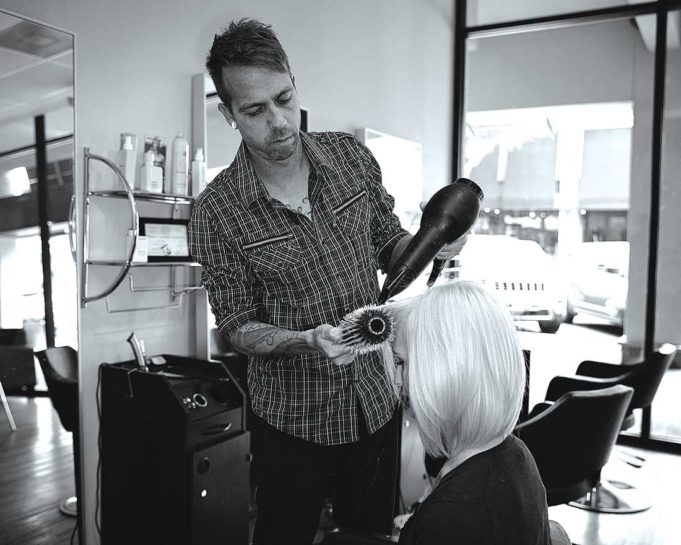Only three years out of cosmetology school, hair stylist London Vincent considered giving up her career. After the salon where she was working unexpectedly closed in early 2016, she was left with few options. She didn’t have enough clients to go out on her own, and she knew joining another salon meant restarting an apprenticeship.
As a compromise, she decided to split the cost of a 100-square-foot suite in the West 7th corridor with a friend. Envy Salon Suites & Spa is part of a new trend in the hairstyling industry. In a traditional salon setting, hairdressers work as employees. In return, salon staffers manage scheduling, pay for advertising, and provide continuing education. But in the growing field of salon suites, hair stylists are working for themselves in partitioned cubicles that range in size from 100 to several-hundred square feet. The idea of being self-employed was appealing to Vincent, and at $350 a month, the rent seemed reasonable.
“I liked it at first,” she recalled. “I liked being my own boss, but six months later, it became very discouraging.”
The suites are designed to maximize the number of tenants, meaning there are few communal spaces where hairdressers can interact with one another. The isolation wasn’t just depressing — it was hurting her creativity.
“You can learn a lot from coworkers,” she said. “When you’re leasing, there’s no one there. There’s no one to ask, ‘What technique did you use to get that cut?’ If I ran into a problem, I was on my own.”
The setting seemed perfect for others, though. Vincent said some of the people around her enjoyed working for themselves. But most of them had spent several years or more building up a large client base. With no help with advertising and little walk-in business, Vincent took on a part-time job to make ends meet and contemplated giving up her career altogether.
The salon suite model has grown considerably in the last five years, said Bridget Sharpe with the Professional Beauty Association, an industry trade group that represents both salon suites and traditional salons.
“We want our stylists to know [salon suites] are a viable career option, but you have to know what you’re getting into first,” she said. “If you’re coming out of school, there’s no receptionist or marketing help. You have to buy your own products and fend for yourself. It could get expensive quickly, especially if you don’t have a client base.”
The rise of salon suites comes at a time when evermore Americans are applying to cosmetology schools. And the overall industry is growing. According to a report by the Professional Beauty Association, between 2004 and 2014, nearly half a million salons opened in the United States. Sharpe said her group doesn’t have enough data to say whether the spike is due to an increase in cosmetology school graduates or public demand. Or both.
Sharpe is working to address several industry challenges. Uneven cosmetology license requirements make it difficult for hairstylists to transfer to other states. Underreporting of income (often in the form of cash tips) to save on income tax has historically plagued the profession and led to an artificially low salary evaluation by the Bureau of Labor Statistics: $11.40 an hour. And right-leaning political advocacy groups such as the Institute for Justice and the American Enterprise Institute are looking to deregulate the field by removing the need for a cosmetology license and oversight boards.
These groups, Sharpe said, have “taken the deregulation and removing red tape argument and put it toward licensing to say, ‘Why should anyone have to go to school for 1,000 hours to become a hairstylist?’ ”
Given the potentially harmful chemicals regularly used by cosmetologists and nail technicians, Sharpe sees serious public health concerns with deregulation.
Vincent left Envy Salon Suites & Spa recently to work at Honeycomb Salon and Colorlab on the West Side. Owner Brandon Rabideau has worked as a hairdresser and salon owner for 10 years, and during that time period, he said, a lot has changed in the industry.
“We’re seeing large changes in my field, similar to what taxi drivers faced” when the ridesharing service Uber arrived, he said. “The salon suites grew really quickly, and everyone had to adjust. Now there is a lot of dissatisfaction in the industry.”
Rabideau has seen many colleagues opt out of the traditional salon setting to rent suites. For a business owner, investing money to train hairstylists now carries new risks –– employees have an easy outlet to which they can turn at any time. Young hairstylists, he said, often under-appreciate the support offered by a traditional salon, Rabideau said. Making progress in the salon industry, he added, requires access to trained professional teachers.
“Like a chef, you can become very successful, but you can’t do it without support,” he said.
Daired Ogle, owner and founder of a network of namesake salons, spas, and beauty schools across Texas, said his main concern for the beauty industry is underreporting of taxes. Though the average cost of attending cosmetology school in Texas is $20,000, he said, “the average income of a hairstylist is artificially low because of underreporting. A lot of parents don’t want to make that kind of investment if their child is going to make just above minimum wage.”
From 2010 to 2014, Ogle chaired the Texas Board of Cosmetology, an industry trade group, which helped him gain insight into the industry. Self-employed hair stylists represent 90 percent of the industry but pay only 33 percent of the reported taxes, he said. A recent report by the Professional Beauty Association confirms the high percentage of hairstylists who work outside traditional salons. Out of the 1.2 million known salon industry employees last year, 1.1 million were listed as self-employed. Sharpe said her group doesn’t have data to know which group pays the larger share of taxes, however.
Ogle understands the allure of avoiding income taxes, but it makes recruiting new hairstylists difficult and undermines the credibility of the cosmetology field.
Sharpe said her staff is working to address that problem, but it “can only do so much because independent contractors work for themselves.”
One possible solution posted on the beauty association’s website is to provide salon suites a tax credit to offset the administrative cost of “ensuring employee compliance on reporting tips.”
With a new administration entering the White House, Sharpe said her group is waiting to see what tax reform possibilities are proposed. The Professional Beauty Association’s main focus, she added, is fighting deregulation attempts in Texas.
The Lone Star State may well be ground zero in that effort. Sharpe said a state bill is being drafted that will eliminate the need for a cosmetology license in Texas.
“Obviously, we’re going to combat that,” she said. “Because Texas’ legislative session is such a short session and it’s only held every other year, we have to focus on this one issue. It’s a health and safety issue.”
To help young hairstylists avoid the situation Vincent found herself in, Sharpe and her staff created the Independent Contractor Project via probeauty.org/contractors.
“I feel in the next five years, a lot of owners are going to come to the realization I’ve come to,” he said. “We have to bring back the environment that was successful. To do that, salon owners are going to have to invest in their employees and in the salon itself. I’m rolling the dice a little on this idea. I try to hire good people I believe in. We’ll see if it works.”












